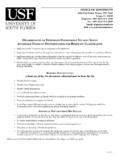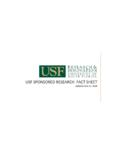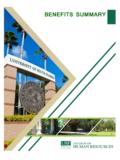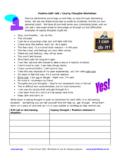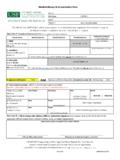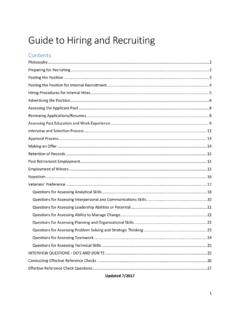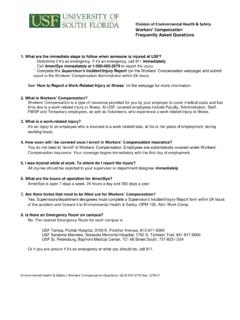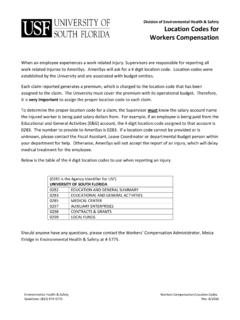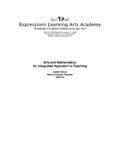Transcription of Tried and True Teaching Methods to Enhance …
1 Tried and true Teaching Methods to Enhance Students Service-Learning Experience Compiled by Professor Diane Sloan, Miami Dade College, and based on the work of Julie Hatcher and Robert Bringle s Reflection Activities for the College Classroom (Indiana University Purdue University Indianapolis) 2 REFLECTION SESSION CLASSROOM STRATEGIES: It is clear that the power in learning is in the action of doing the activity. Reflection provides the same power through the action of articulating thoughts. Reflection is the necessary bridge in the learning process that takes place when a student is involved in a service-learning experience. There are the traditional strategies such as writing in journals, reporting orally in front of the class, or writing an essay describing the experience.
2 The following examples will include and also move ahead of the Tried and true , giving the facilitator a variety of other Methods that he/she might like to incorporate in the classroom. Index of Reflection Techniques: 1. Personal Journals .. pg 3 2. Dialogue pg 3 3. Highlighted 3 4. Key Phrase 3 5. Double-entry pg 3 6. Critical Incident pg 4 7. Three-part pg 4 8. Free Association 4 9. pg 5 10. Quotes in 5 11. Reflective pg 6 12. Directed 6 13. Experiential Research pg 6 14. Service-Learning Contracts and pg 6 15. Directed 7 16. Ethical Case 7 17. Class pg 7 18. Truth is Stranger than pg 7 19. Student 8 20. It s My 8 21. It s Your Thing/Express 8 22. Small Group 9 23. Email Discussion 9 24. Class 9 3 REFLECTION JOURNALS: (A note about reflection journals: a common tendency is for journal entries to become a mere log of events rather than a reflective activity in which students consider the service experience in the context of learning objectives.)
3 Guidance is needed to help students link personal learning with course content.) 1. Personal Journal Students will write freely about their experience. This is usually done weekly. These personal journals may be submitted periodically to the instructor, or kept as a reference to use at the end of the experience when putting together an academic essay reflecting their experience. (Hatcher 1996) 2. Dialogue Journal Students submit loose-leaf pages from a dialogue journal bi-weekly (or otherwise at appropriate intervals) for the instructor to read and comment on. While labor intensive for the instructor, this can provide continual feedback to students and prompt new questions for students to consider during the semester. (Goldsmith, 1995) 3. Highlighted Journal Before students submit the reflective journal, they reread personal entries and, using a highlighter, mark sections of the journal that directly relate to concepts discussed in the text or in class.
4 This makes it easier for the instructor to identify the student to reflect on their experience in light of course content. (Gary Hesser, Augsberg College) 4. Key Phrase Journal In this type of journal, students are asked to integrate terms and key phrases within their journal entries. The instructor can provide a list of terms at the beginning of the semester or for a certain portion of the text. Students could also create their own list of key phrases to include. Journal entries are written within the framework of the course content and become an observation of how course content is evident in the service experience. (Hatcher 1996) 5. Double-entry Journal When using a double-entry journal, students are asked to write one-page entries each week: Students describe their personal thoughts and reactions to the service experience on the left page of the journal, and write about key issues from class discussions or readings on the right page of the journal.
5 Students then draw arrows indicating relationships between their personal experiences and course content. This type of journal is a compilation of personal data and a summary of course content in preparation of a more formal reflection paper at the end of the semester. (Angelo and Cross 1993) 4 6. Critical Incident Journal This type of journal entry focuses the student on analysis of a particular event that occurred during the week. By answering one of the following sets of prompts, students are asked to consider their thoughts and reactions and articulate the action they plan to take in the future: Describe a significant event that occurred as a part of the service-learning experience. Why was this significant to you? What underlying issues (societal, interpersonal) surfaced as a result of this experience?
6 How will this incident influence your future behavior? Another set of questions for a critical incident journal includes the following prompts: Describe an incident or situation that created a dilemma for you in terms of what to say or do. What is the first thing you thought of to say or do? List three other actions you might have taken. Which of the above seems best to you now and why do you think this is the best response? (Hatcher 1996) 7. Three-part Journal Students are asked to divide each page of their journal into thirds, and write weekly entries during the semester. In the top section, students describe some aspect of the service experience. In the middle of the page, they are asked to analyze how course content relates to the service experience. And finally, an application section prompts students to comment on how the experience and course content can be applied to their personal or professional life.
7 (Bringle 1996) 8. Free Association Brainstorming (This reflection session should take place no earlier than the end of the first 1/3 of the project experience.) Give each student 10-20 post-its and ask them to write down all the feelings they had when they first heard about their service-learning requirement. After they finish the first question, have them write down all of the feelings they had when they experienced their first field encounter. After finishing question two completely, have them write down all of the feelings they are having right now regarding their service-learning experience. Encourage them to write down as many different brainstormed thoughts as possible (one for each card). Have three newsprint papers strategically located and taped to the walls around the classroom. Have one with a large happy face, one with a sad face, and one with a bewildered face.
8 Ask students to now place their words on the newsprint paper that closest fits their brainstormed feelings. Then have them stand next to the newsprint that has most of their feelings. This exercise involves both writing and speaking and is seen as non-threatening in an oral presentation sense. (Sloan 1996) 59. Quotes Using quotes can be a useful way to initiate reflection because there is an ample supply of them, and they are often brief and inspiring. Here are some quotes as examples you might want to use: If we do not act, we shall surely be dragged down the long, dark and shameful corridors of time reserved for those who possess power without compassion, might without morality, and strength without insight. ---Dr. Martin Luther King, Jr. A different world cannot be built by indifferent people.
9 ---Horace Mann I believe that serving and being served are reciprocal and that one cannot really be one without the other. ---Robert Greenleaf, educator and writer Never doubt that a small group of thoughtful, committed citizens can change the world: indeed, it s the only thing that ever has. ---Margaret Mead Unless you choose to do great things with it, it makes no difference how much you are rewarded, or how much power you have. ---Oprah Winfrey Quotes may be used in a variety of ways. You might give each student a page of quotes and ask them to pick one that fits his/her feelings about the service-learning project. Then you could ask them to explain why this quote represents his/her feelings. The best results seem to be when the students are given the sheet one session before the reflection class.
10 This gives them time to put their thoughts together. The students could also do it as a one-minute paper that might then be read and explained to the rest of the class. (Diane Sloan, Miami Dade College) 10. Quotes in Songs Ask the students to find a song where the singer uses lyrics that describe what he/she feels about the service-learning project. Emphasize that it does not need to be a whole song but a lyric in a song. If they have access to the song, tell them to bring it to play at the end of the reflection session. Even if they do not have the song, ask them to say the lyric that describes their feelings. This usually proves to be fun in a sense that it creates a casual atmosphere and bonds the group together. Many 6times others will help by trying to sing it with them. Playing the songs usually creates a celebratory atmosphere.
